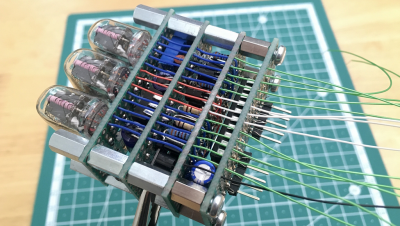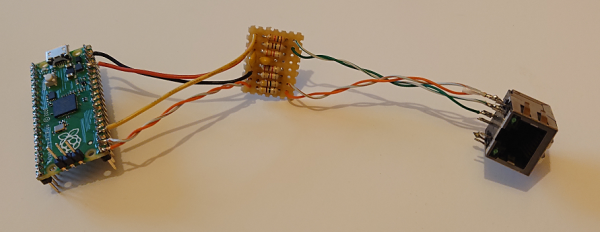With all the attention given to heart rate monitoring and step counting, respiratory rate monitoring is often overlooked. Smartwatches are starting to incorporate respiratory rate monitoring more and more these days. However, current devices often simply look at breaths per minute without extracting more interesting features of the respiratory waveform which could give us more insight into our bodies than breaths per minute could alone. [Davies] and his team decided they wanted to change that by making an earbud that can measure respiratory rate. Continue reading “Breathe Through Your Ears?”
This Is The Future Of Waste Management
Many of us have been asking for some time now “where are our robot servants?” We were promised this dream life of leisure and luxury, but we’re still waiting. Modern life is a very wasteful one, with items delivered to our doors with the click of a mouse, but the disposal of the packaging is still a manual affair. Wouldn’t it be great to be able to summon a robot to take the rubbish to the recycling, ideally have it fetch a beer at the same time? [James Bruton] shares this dream, and with his extensive robotics skillset, came up with the perfect solution; behold the Binbot 9000. (Video, embedded below the break)
A Cycle-Accurate Intel 8088 Core For All Your Retro PC Needs
A problem faced increasingly by retrocomputer enthusiasts everywhere is the supply of chips. Once a piece of silicon goes out of production its demand can be supplied for a time by old stock and second hand parts, but as they become rare so the cost of what can be dubious parts accelerates out of reach. Happily for CPUs at least, there’s a ray of hope in the form of FPGA-based cores which can replace the real thing, and for early PC owners there’s a new one from [Ted Fried]. MCL86 is a cycle accurate Intel 8088 FPGA Core that can be used within an FPGA design or as a standalone in-circuit replacement for a real 8088. It even has a full-speed mode that sacrifices cycle accuracy and can accelerate those 8088 instructions by 400%.
Reading the posts on his blog, it’s clear that this is a capable design, and it’s even been extended with a mode that adds cache RAM to mirror the system memory at the processor’s speed. You can find all the code in a GitHub repository should you be curious enough to investigate for yourself. We’ve pondered in the past where the x86 single board computers are, perhaps it could be projects like this that provide some of them.
Better Coding Through Sketching
Back in the late 1970s and early 1980s, engineering students would take a few semesters of drafting and there would usually be a week or two of “computer-aided drafting.” In those days, that meant punching cards that said RECTANGLE 20,30 or something like that and getting the results on a plotter. Then we moved on to graphical CAD packages, but lately, some have gone back to describing rather than drawing complex designs. Cornell University researchers are trying to provide the same options for coding. They’ve built a Juypter notebook extension called Notate that allows you to sketch and handwrite parts of programs that interact with traditional computer code. You can see a video about the work below.
The example shows quantum computing, but the idea could be applied to anything. The example has sketches that generate quantum circuits. Naturally, there is machine learning involved.
Build Your Own Mini Fogging Cauldron
The best cauldrons are full of bubbling, steamy potions of great magical potential. We don’t have many of those in the real world, though, so sometimes we have to make do with a simulacra. [wannabemadsci] has built just that, with this fogging cauldron prop that uses no fog fluid or dry ice, running solely with water instead.
The heart of the build is a piezo element that vibrates at ultrasonic frequencies to atomize water. They’re available from websites like AliExpress complete with a driver circuit to energize the piezo element. The water is delivered from a wetted fiber wick, and quickly becomes a fog when the piezo is energized.
The disk was installed in a custom PVC water cup with the wetted wick, along with the electronics. The assembly was then lowered into an off-the-shelf plastic cauldron party favor to complete the look. The trick is to mount the piezo element sideways to get a nice-looking distribution of fog. A green LED was installed to light the cauldron from within.
The resulting effect is a sinister-looking glowing cauldron with a steady stream of fog emanating from the top. It’s a great piece of Halloween decor, and as a bonus, it doesn’t require any fancy chemicals to make it work. If you’re thirsty for more, be sure to check out the winners of last year’s Halloween Hackfest. Video after the break.
Bit-Banging Bidirectional Ethernet On A Pi Pico
These days, even really cheap microcontroller boards have options that will give you Ethernet or WiFi access. But what if you have a Raspberry Pi Pico board and you really want to MacGyver yourself a network connection? You could do worse than check out this project by [holysnippet] that gives you a bit-banged bidirectional Ethernet port using only scrap passive components and software.
This project is similar to one we shared back in August by [kingyo], but differs in that what [holysnippet] has achieved is a fully-functional (albeit only around 7 Mbps) Ethernet port, rather than a simple UDP transmit device. The Ethernet connection itself is handled by the lwip stack. Connection to the RJ45 socket can be made from any of the Pi Pico pins, provided TX_NEG is followed directly by TX_POS, but the really hacky part is in the hardware.

Rather than developing hardware that would protect the Pico, this design admits that it “shamefully relies on the Pico’s input protection devices” to limit the Ethernet voltages to 3.3 V.
You’ll need an isolation transformer from some old Ethernet-enabled gear (either standalone or as part of a magnetic jack), but then it’s only resistors and capacitors from there. There are warnings not to connect this to PoE networks for obvious reasons, and the component layout needs to keep in mind the ~20 MHz frequencies involved, but to get this working at all feels like quite a feat.
Normally, there’d be no reason to go to these lengths, but it’s always educational to see if it can be done and, with the current component shortages, this is another trick to keep up your sleeve for emergencies!
Putting ports where they shouldn’t belong is not a new idea, of course. Back in the day we even shared an inadvisable ATTINY implementation of bit-banged Ethernet with no protection at all.
Thanks to [biemster] for the tip-off
Nixie Display Module Is Addressable Via SPI
There are plenty of SPI interface screens on the market, but few of them have the charm of the good old Nixie tube. [Tony] decided to whip up a simple three-Nixie module that could be addressed via SPI.

The module relies on a PIC16F15344 microcontroller to run the show, using its built-in SPI interface. It’s built with four stacked-up PCBs for ease of assembly and testing. It uses an internal buck converter to create the 170 volts required for the Nixie tubes from a 6 to 12 volt input. The high-voltage lines are routed towards the inside of the stack to minimize any nasty shocks when handling, though caution would still be advisable.
Driving the display is as simple as sending 16-bit words over the SPI interface, with the device operating in SPI client mode 1. If you’re looking for a simple way to have projects write output to a nice Nixie display, this module could be just what you’re looking for. Alternatively, if you can’t lay your hands on the tubes, there are other pretty solutions out there, too. Video after the break.
Continue reading “Nixie Display Module Is Addressable Via SPI”

















